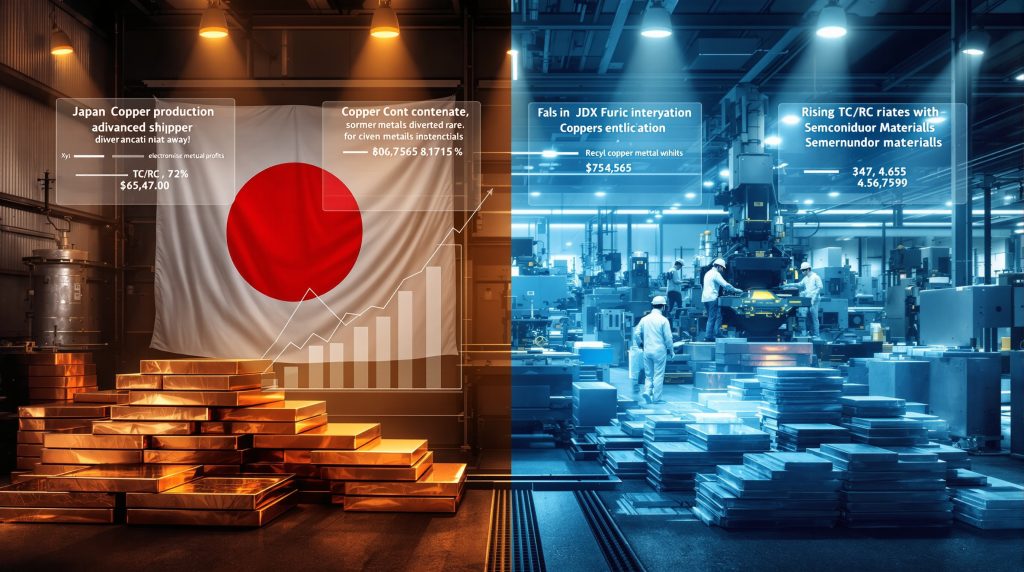Why Is JX Advanced Metals Cutting Copper Production?
Market Pressures Force Strategic Shift in Copper Smelting
JX Advanced Metals, one of Japan's leading copper smelters, has announced significant production cuts for fiscal year 2025. This strategic decision reflects broader challenges facing the global copper industry and signals important shifts in the metal processing landscape.
What Production Cuts Has JX Advanced Metals Announced?
Scale and Scope of the Reduction
JX Advanced Metals plans to reduce its copper production by several tens of thousands of tonnes from previous projections for fiscal year 2025 (ending March 2026). The company, which possesses an annual production capacity of 450,000 tonnes, had previously hinted at potential production cuts but has now confirmed this significant operational adjustment.
Based on company statements, the reduction likely represents 5-8% of total capacity, potentially decreasing refined copper output by over 30,000 tonnes. This adjustment will impact operations at Pan Pacific Copper Co., where JX holds a 48% stake with an annual refined copper capacity of 650,000 tonnes.
Impact on Operational Strategy
The production cuts reflect a calculated response to challenging market conditions rather than temporary measures. Company president Yoichi Hayashi has indicated that these reductions are necessary due to the inability to procure copper concentrates under current market conditions.
"We simply cannot continue operating at previous levels given the current concentrate procurement challenges," industry analysts noted in recent market assessments.
What's Driving the Production Cutbacks?
Global Concentrate Supply Challenges
The primary factor driving these cuts is the increasingly difficult procurement of copper concentrate, the essential raw material for copper smelting. The global copper supply forecast has tightened significantly, creating unfavorable conditions for smelters.
Supply constraints from major mining regions, combined with production disruptions at key mines, have contributed to a fundamental imbalance between concentrate availability and smelting capacity. This mismatch has altered the power dynamics between miners and smelters.
Treatment and Refining Charges Crisis
TC/RCs (Treatment and Refining Charges) have fallen dramatically to historic lows. These charges, which represent the main revenue source for smelters processing concentrate into refined copper, have been squeezed to unsustainable levels.
Some Chinese smelters are reportedly processing copper for Chilean miner Antofagasta without fees, a development that would have been unthinkable just a few years ago. Japanese smelters and global miners failed to reach TC/RC agreements during annual negotiations, forcing companies to forgo contracted term supplies.
Most concerning for the industry are reports of negative TC/RCs being demanded by miners in some spot transactions—an unprecedented situation where smelters would effectively pay miners for the privilege of processing their concentrate.
Chinese Competition Intensifies Market Pressure
The expansion of Chinese smelting capacity has created additional competitive pressure, further squeezing margins for Japanese producers like JX Advanced Metals. This has fundamentally altered the economics of copper smelting in Japan.
Chinese smelters added approximately 1.5 million tonnes of new capacity in 2024 alone, with more expansions planned. This surge in capacity has intensified competition for limited concentrate supplies, with Chinese operators often willing to accept lower TC/RCs to maintain utilization rates.
How Is JX Advanced Metals Responding?
Strategic Capacity Reduction
Beyond immediate production cuts, JX Advanced Metals is considering a more permanent reduction in its smelting capacity to mitigate risks associated with concentrate procurement and unfavorable market conditions. While the exact extent of this reduction hasn't been specified, it represents a significant strategic pivot.
"We are reviewing the optimal scale from various perspectives, including the use of recycling materials," Hayashi stated, indicating a more fundamental rethinking of the company's approach to copper processing.
Export Market Reconsideration
Approximately half of JX's refined copper is exported, with China being the primary destination. However, with new domestic smelters coming online in China, demand for Japanese copper exports may decline, prompting JX to reconsider its market positioning.
This export vulnerability adds another layer of complexity to JX's strategic challenges, potentially necessitating a more significant transformation of its business model.
Industry-Wide Response
JX Advanced Metals isn't alone in this strategic shift. Mitsubishi Materials, another major player in the Japanese copper industry, is reportedly considering similar reductions in response to the same market pressures.
These parallel moves suggest an industry-wide recognition that structural changes, rather than cyclical adjustments, are required to address the fundamental shifts in global copper processing economics.
What's the Future Direction for JX Advanced Metals?
Pivot to Semiconductor Materials
JX Advanced Metals is strategically shifting its focus from traditional mining and smelting operations toward semiconductor materials, which offer higher margins and growth potential in today's technology-driven economy.
This pivot leverages the company's metallurgical expertise while moving up the value chain into more specialized, less commoditized product areas. The semiconductor materials market is projected to grow at a compound annual rate exceeding 8% through 2030, offering more attractive growth prospects than traditional copper smelting.
Rare Metals Recovery and Recycling
Despite production cuts, JX's president Yoichi Hayashi emphasized the continued importance of smelting operations for recovering rare metals such as tantalum, which are vital for semiconductor materials—a key growth area for the company.
This focus on rare metals recovery represents a value-added approach to smelting that goes beyond traditional copper refining, potentially offering higher margins and strategic advantages in securing critical materials.
Recycling Expansion Strategy
The company is increasing its focus on copper and niche metals recovery from electronic waste, developing industrial scrap processing capabilities to reduce reliance on primary concentrate supply. This circular economy approach improves business profitability while addressing sustainability concerns.
Key elements of the recycling strategy include:
- Developing proprietary technologies for efficient recovery of multiple metals from complex e-waste
- Establishing collection networks for consistent supply of recyclable materials
- Creating closed-loop systems with key industrial partners
- Leveraging existing metallurgical expertise for processing complex secondary materials
Mineral Sands Investment
In June, JX Advanced Metals announced plans to acquire a stake in the Copi mineral sands project in Australia, led by RZ Resources. This investment aims to secure rare metals essential for chip materials, supporting the company's strategic pivot toward higher-value products.
The Copi project contains significant deposits of titanium, zirconium, and rare earth elements—all critical inputs for advanced electronics and semiconductor manufacturing. This investment represents a vertical integration strategy to secure vital raw materials for the company's growth sectors.
What Are the Financial Implications?
Improved Financial Outlook
Despite the production challenges, JX Advanced Metals has updated its annual profit projections upward. Company president Hayashi expressed optimism about achieving the financial goals set for 2027, which include an operating profit margin ranging from 12% to 17%.
This positive financial outlook, despite smelting challenges, suggests that the strategic pivot is already yielding benefits. The higher-margin semiconductor materials business is offsetting potential losses from reduced copper smelting activities.
Long-Term Financial Targets
The company has established an ambitious long-term objective to significantly increase its operating profit to $1.7 billion (¥251.9 billion) by 2040, indicating confidence in its strategic repositioning despite current market challenges.
This target represents approximately triple the company's current operating profit, reflecting expectations of substantial growth in its higher-value business segments.
Business Decision-Making Improvements
Since its stock exchange debut in March, JX Advanced Metals has focused on refining its decision-making processes and improving communications with investors, suggesting a more transparent and agile approach to business management.
These governance improvements may enhance the company's ability to navigate complex market transitions and build investor confidence in its long-term strategy.
What Does This Mean for the Global Copper Market?
Industry Rebalancing
The production cuts by JX Advanced Metals and potentially other smelters represent part of a broader industry trend aimed at reducing excess smelting capacity to rebalance the market after a period of overcapacity, particularly in China.
This rebalancing could eventually lead to improved TC/RC rates as the supply-demand dynamics between miners and smelters normalize. However, this process may take several years to fully play out.
Supply Chain Implications
These reductions may have ripple effects throughout the copper supply chain, potentially affecting pricing and availability of refined copper in certain markets, particularly in Asia.
Market Insight: The copper supply chain is undergoing its most significant restructuring in decades, with implications for everyone from miners to end-users of refined products.
While global copper supplies remain adequate overall, regional imbalances may develop as traditional trade patterns adjust to new realities of smelting capacity distribution.
Japanese Smelting Sector Under Pressure
Japan's copper smelting industry, the world's fourth-largest, faces significant challenges. However, Hayashi noted that some miners are open to negotiating different terms with Japanese companies compared to Chinese benchmark deals, which could provide some support for the sector.
This differentiation reflects the quality reputation of Japanese smelters and their importance in maintaining diversity in the global processing landscape.
What's the Outlook for Copper Smelting in Japan?
Selective Investment Approach
JX Advanced Metals is taking a more cautious approach to future investments, noting that any new projects would be smaller than its previous Chilean copper mine venture, which resulted in significant impairment losses.
This selective approach prioritizes lower-risk investments with clearer pathways to profitability, reflecting lessons learned from past ventures and the challenging current market environment.
Focus on Efficiency and Value-Added Products
Rather than competing directly with Chinese smelters on volume, Japanese producers appear to be pivoting toward higher-efficiency operations focused on value-added products and specialized materials recovery.
This approach leverages Japan's technological advantages and skilled workforce while avoiding direct competition in commoditized segments where Chinese producers enjoy scale advantages.
Technological Innovation
The emphasis on rare metals recovery and semiconductor materials suggests a future where Japanese smelters leverage their technological advantages to maintain relevance despite challenging market conditions for traditional copper smelting.
Key areas of innovation include:
- Advanced separation technologies for complex material streams
- Energy-efficient processing methods to reduce operational costs
- Specialized refining techniques for ultra-high purity materials
- Integrated recycling systems for closed-loop material recovery
Strategic Adaptation in a Changing Market
JX Advanced Metals' decision to cut copper production represents a strategic adaptation to fundamental changes in the global copper market. By reducing exposure to unfavorable smelting economics while pivoting toward higher-value materials and recycling, the company is positioning itself for sustainable long-term growth despite current challenges in its traditional business areas.
The careful balancing of traditional smelting operations with emerging opportunities in semiconductor materials and recycling demonstrates a thoughtful approach to industry transformation. While maintaining core metallurgical capabilities, JX is evolving toward a more diversified, higher-margin business model.
The company's approach may serve as a model for other smelters facing similar pressures, potentially accelerating the industry's transition toward more sustainable and economically viable operational models in an increasingly competitive global market. Furthermore, this strategic pivot comes at a time when copper price predictions remain volatile and copper price collapse analysis suggests continued uncertainty.
For investors seeking copper investment insights or companies looking to implement industry innovation trends, JX Advanced Metals' strategic realignment offers valuable lessons in adaptive business management during challenging market conditions.
Disclaimer: This analysis contains forward-looking statements about market conditions and company strategies. Actual outcomes may differ from projected developments based on unforeseen market shifts, regulatory changes, or other factors.
Want to Stay Ahead of Significant Mineral Discoveries?
Discovery Alert's proprietary Discovery IQ model provides instant notifications when major mineral discoveries are announced on the ASX, helping investors make informed decisions before the broader market reacts. Explore why historic discoveries can generate substantial returns by visiting Discovery Alert's dedicated discoveries page.




